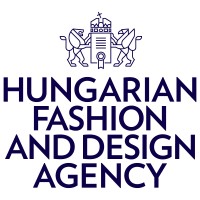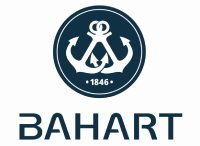Hydrofoils in Hungary
On foils for 30 years
MAHART Hydrofoil service 1962-1992
By Ervin Marczis
Published in the Transport Science Gazette, June 1993
1. Introduction
When Hungarian Shipping Rt (MAHART), the successor of the Hungarian-Soviet Shipping Rt (MESZHART), regained its independence on January 1, 1955, it immediately developed and began the implementation of a large-scale technological and economic plan. This plan, the first phase of which was implemented roughly between 1955 and 1968, covered the entire field of domestic shipping, on the Danube and Lake Balaton, and international shipping.
It entailed building new boats, enlarging the fleet and reconstructing the machine rooms and boards of existing boats. Last but not least, this was complemented by the organizatonal modernization of the commercial and traffic control systems.
Since its establishment 98 years ago, Hungarian state shipping has never had such a spectacular and also effective developmental period. Revolutionary plans came into operation both both in naval and river shipping and, as a part of this pioneering progress, Mahart was the first to start hydrofoil shipping on the Middle- and Upper-Danube sections.
1962-1992
2. Historical background of the development of hydrofoil and hovercraft shipping
At the turn of the century, after nearly 10 years of experimentation from 1895 to 1905, Italian engineer Enrico Forlanini managed to demonstrate the main principles still used today by the hydrofoil boat he had constructed. Namely, that by means of wings fixed on the hull below the surface of the water, the boat gradually emerges from the water due to hydrodynamic buoyancy as it gains speed. As a consequence, the boat breaks away from the hydrodynamic resistance of water and, depending on the power of its engine, can reach substantially higher speeds.
As for the forming of the foils, there are two versions currently in use that provide stability: the front-rear fixed shallow-submergence horizontal river type and the front-rear fixed deep-submergence V-shaped naval type.
In order to further increase stability, the main foils are complemented by secondary and brake wings, as well as glide plates fixed on the hull.
Hydrofoil experiments were run not only in Italy, but also in England, America and Germany until the eve of World War II, some based on Forlanini’s experiments and others seeking new ways. Achievements in Germany were particularly impressive and noteworthy in several aspects, although these experiments were mainly motivated by military purposes.
Meanwhile, another opportunity for increasing speed was also explored as the hovercraft principle was developed for civic use. The Italians were extremely successful in using this technology for military purposes during World War I.
In Hungary, Dr Kornél Fényes, an outstanding researcher of hydrodynamics and propellers and a university lecturer at the University of Technology, and engineer and mechanical engineer Iván Fényes dealt with this issue between 1930 and 1935. The main purpose of their experiments was to develop a special boat which, reaching a certain speed, would gradually decrease its submergence and would barely submerge at full speed.
Dr Kornél Fényes and his associate took two longer trips on the Budapest-Gönyű and Budapest-Vienna routes with the 15 horsepower petrol-fuelled gliding boat in 1933, reaching an average speed of 40 km per hour. But Hungary’s industrial and technological background was not sufficient for further considerable development, so gliding boats were not widely used, except for military and sports shipping. After world War II, hydrofoil shipping again became the focus of attention.
Nations with traditions in shipbuilding (Italy, England, Sweden, Russia, etc.) made significant progress within a few years in developing light-structure boats made of a more solid aluminum-magnesium alloy, and also succeeded in designing light engines with significantly improved performance.
In Hungary, the Vác plant of the Hungarian Dockyard and Crane Factory, which specialized in aluminum structures, built two- and four-seater hydrofoil sports boats, then a 60-seater boat in 1958-1959. The hydrofoil boat “FECSKE”, designed by constructors Gábor Fekecs and Dezső Beleki, made test runs on the Danube but was not eventually put in permanent use. The reason, just as in the case of gliding boats some three decades ago, was that the limited scope of Hungary’s industrial background obstructed further development, and also that the Soviet Union had already started the mass production of hydrofoil boats.
Dynamic development in the Soviet Union began in 1943. Its first phase finished by 1958, when production of the small, 6-seater VOLGA and NEVKA models as well as the bigger, 64-seater RAKETA hydrofoil boats began. In 1960, Soviet inland navigation already ran hydrofoil boats on 23 lines. Meanwhile, engineers were already designing big, modern naval, inland sea and river boats with 120-250 seats, such as the METEOR, VOSHOD, KOMET, the gas turbine driven ZYKLON, and today’s state-of-the-art POLESJE. The Soviet dockyards produced hydrofoil boats in surprising quantities and at a fast pace.
The Soviet boats made promotional trips in the most significant ports of Scandinavia, Western Europe, the Mediterranean and the Far East regions, organized by their foreign trade company, SUDOIMPORT. These trips, and the hydrofoil boats themselves, commanded the attention of professionals everywhere and the newspapers and trade magazines of the time reported on them in detail.
The primary power source of the boats, depending on the bearing capacity, was one or a pair of type M400, M401 or M401 A-2 diesel engines with 12 cylinders in a V configuration and output of 736 kW. The consumption of the engines in the 1500-1800 rev range at 60-70 km per hour was 130-190 kg an hour. An interesting fact about the origin of these engines is that they got to the Soviet Union in large quantities in1942 within the framework of an earlier lend-lease contract in which the USA agreed to provide military equipment.
The 1950s saw the emergence of a revolutionary new shipping technology developed by British engineer Christopher Cockerrel in order to increase speed: the hovercraft. Two types of hovercraft were developed and used. In one type, the aircushion under the boat is surrounded by a soft, flexible wall, and in the other the side is hard and the aircushion is surrounded by soft material only at the bow and the stern of the boat. The former is driven by 1 or 2 above-water propellers, so it can run overland on the banks and shores, while the hard-sided type is propulsion-driven and can thus only run on water.
Well-known hovercraft types include the SRN, which is produced by British company Sanders Roe and runs on the English Channel and, in the smaller category, the hard-sided HM-2 model produced by Hovermarine Ltd. The latter boat will be discussed in detail in the next chapter.
As for the further development opportunities, hovercrafts showed more promise for military uses, especially when used as amphibious vehicles. Even today, there is disagreement in professional circles as to whether hydrofoil boats or hovercrafts are more economic in commercial use (passenger transport and the shipping of goods). The specific costs per passenger or per ton of cargo are relatively high in both cases. Shipping companies decide which type to use to meet their business objectives based on a comparative analysis of routes, the frequency of the lines (calculating with the seasonal or the full period), the number of seats or cargo capacity, the cost of transportation and several other factors.
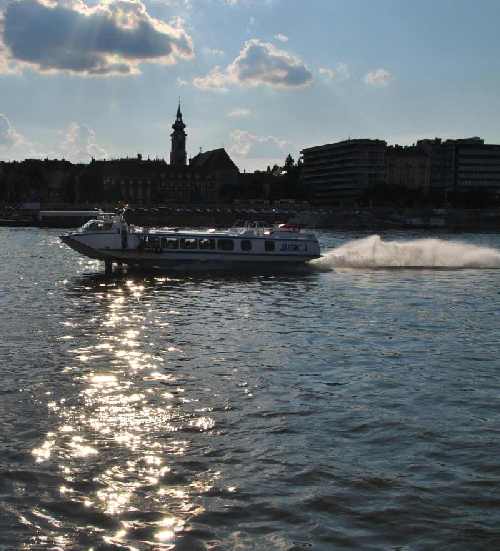
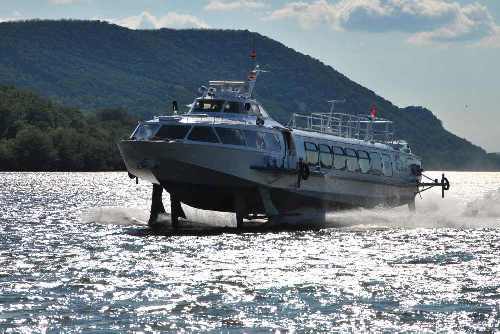
3. The hydrofoil fleet of MAHART
Comfort standards, boat and traffic security and the background of passenger traffic
MAHART gave a purchase order to NIKEX for two Soviet RAKETA hydrofoil boats in 1961. The boats, wearing the production numbers 283 and 291, were produced in Theodosia in the Crimean Peninsula, and were shipped to Budapest in August 1962. During their registration process, the boats received the names SIRÁLY I and SIRÁLY II. MAHART bought two 6-seater VOLGA hydrofoils in 1963, FECSKE I and FECSKE II, but it turned out it did not have any significant plans with them so the boats were given to the trade unions (SZOT) and the Tokaj city council in 1968.
MAHART gave economic and technological consideration to the possibility of using hovercrafts along its hydrofoil boats in developing faster passenger transport. The company chose the British HM2 model mentioned above, which had nautical features somewhere between those of VOSHOD and POLESJE, but had weaker technological attributes. This plan was never realized because of exchange control regulations. However, the HM2 appeared in Budapest in 1986: it sailed under Austrian colors until 1990 under the name of DONAUPFEIL as a regular Vienna-Budapest line.
New and previously unknown challenges arrived with the hydrofoils. Their great speed compared to traditional boats, and closely related to this, the ever-changing conditions of shipping routes created new ergonomic conditions.
These new challenges became personalized regardless of the position of employees. For the past 30 years, four generations of board crews have learned and performed their duties, and the same happened to three generations of engine room staff. In addition to their professional competence, the mental stability of officers has been checked since the mid-80s in periodical psychological examinations.
As for the quality of transportation, little attention was paid to the acoustic design of the boats in the 1950s and 1960s. For example, the passenger area of the SIRÁLY boats was directly next to the engine room, so an average noise level of 84 dB could be measured in the passenger room and 75 dB on the bridge, not to mention the 114 dB noise level in the unattended engine room.
The new types of hydrofoil boats arriving in 1971 and 1977, the SÓLYOM and the VÖCSÖK, brought immeasurable improvements in quality in this as well as other regards. Thanks to the interior design of the boats, the noise level in passenger areas was significantly (35-40 dB) lower than even international standards, with the exception of the hindmost of the SÓLYOM’s three passenger halls.
When passengers, foreigners or Hungarians, take their seats in a hydrofoil boat, they would like to be informed about the boat and the route in details, even if they had inquired before. This purpose was served by recorded voice information about the boat and the route in three languages. Starting from 1986, this service has been provided by the hosting staff. Passengers can obtain further information using an electronic display route map.
THE NEW YORK TIMES reporter Nona Brown gave an account of her journey on the SIRÁLY I in an article that had all the makings of an advertisement in the November 21, 1965 issue of the newspaper, promoting this novelty of the Central European tourism industry overseas. Subsequently, American film studios and TV channels indicated their intention to make route reports one after the other. At the time, only the domestic and foreign travel agency branches of IBUSZ dealt with catering and ticket distribution besides MAHART, services performed by hundreds of agencies nowadays.
The boats’ canteens were supplied by UTASELLÁTÓ for three decades, which also operated catering services and duty-free shops. The standard of service was more or less satisfactory for international lines. Nowadays, this task is handled by MAHART’s own staff and goods supply.
The next step in raising the standards was supplying the boats with public payphones, so passengers can make phone calls to any part of the world connected to the international telecommunications satellite system. At present, this system can only be used westwards from the boundary of the satellite’s broadcast and reception range, which is in the region of Dunaremete geographically speaking.
The complete safety of the boats has always been assured by yearly register inspections, the purpose of which is to assess the mechanical condition of the boats. The navigation system was expanded in the 1970s and 1980s to include radars and long-range VHF radiophones.
From the point of view of tourism Hungary, and especially Budapest, has a central position in Central Europe both as a destination and as a transit station. As a result, passenger shipping can scarcely satisfy the demands of landing, catering and passenger traffic, especially compared to international standards. Of course, this goes for all boat traffic, not just hydrofoils.
The International Boat Port on Belgrád Quay was opened in 1937. At the time it was considered a very modern building. In recent decades, MAHART has tried to keep up with the growing needs of tourism on a very low budget. It also had to restore flood damages several times.
Those involved in tourism will have to find a quick solution for establishing an international river port that should be up-to-date in all aspects, taking the aesthetic and at the same time functional Praterka port in Vienna as a model, as an open tender called in 1986 has already suggested.
4. Risks, responsibilities, reasons and lessons
In the previous chapter, the new challenges that had arrived with hydrofoil boats in 1962 have already been mentioned. But in reality these challenges came into the limelight only 10-20 years later.
When an accident happens, an official expert is responsible for establishing the collateral facts, for finding the professional and material correlations and for providing an objective response. I will also use the expert report as a base in sharing the details of a certain accident in brief and in chronological order, complemented by various points of view. Let me begin with the accident of the SIRÁLY II, which was the consequence of violating the main principle “see and be seen”. The SIRÁLY II started its journey with 52 passengers from Vienna to Budapest at 2.20 pm on September 9, 1972. It dropped anchor in the vicinity of Esztergom for 20-30 minutes because of mechanical problems, then resumed progress in a light rain.
At Nagymaros the captain ordered two of the officers to perform increased vigilance because of the dark and the rain, and also switched on the two front lights. Later on, he switched the lights off because the diffused light caused by the rain was disturbing. Arriving in the Újpest-Megyer area, the captain gave a progress report at 7 pm, and a few minutes later the boat slightly tilted on its right side with a thud.
The front stabilizer of the SIRÁLY II, out of line of sight, collided into a powerboat which crossed its path in a roughly 50-degree angle without the lights on. The two male passengers of the boat, who were covered by canvas to protect them from the rain, died immediately, and the two female passengers were rescued by the crew of the ESZTERGOM towboat passing nearby. The captain, assuming that the boat had hit driftwood, acted in accordance with hydrofoil shipping practice: he braked, sat the boat, backed up and continued the journey on hydrofoils.
The first expert opinion was found insufficient, but the second investigation and further expert opinion closed the legal procedure saying that the powerboat without the lights on violated Shipping Regulations at several points, while theoretical and practical evidence suggested that the powerboat had been impossible to spot from the SIRÁLY II.
The essence of the details of the following accident, as the expert suggests in his report, is connected to one of the main principles of labor psychology: “any employee in transportation service struggling with private life problems can jeopardize the safety of transportation”. Regarding the professional aspect, risks can be reasonably taken only as long as it is in line with the rules and with professional practice. Finally, this was the first time the crews of our hydrofoil boats faced the nautical problem of whether the boats would sink. The SIRÁLY I started its journey with 45 passengers from Vienna to Budapest at 2.30 pm on September 5, 1983. Leaving Vienna, the boat caught up with Russian motor towboat VILNIUS and its barge. The SIRÁLY I remained in its wake for a short while, but did not leave the lane in time and due to the strong waves, the vacuum effect and extraordinary water movements, it was unable to pass the towboat.
The SIRÁLY I crashed into the corner of the last barge. The barge tore the left side of the passenger compartment open, nine seats with the passengers in them piled up, and two of the eight watertight airboxes were holed, which resulted in the front part of the floor of the passenger area getting under water. (According to Register Rules, the hydrofoil boat is unsinkable if “any one of the airboxes springs a leak”.) Two passengers died, one fell into the Danube from his seat and was rescued by fishermen, and 33 passengers were injured.
After the crash, the engine room master navigated the SIRÁLY I to the opposite bank of the river and shored the boat as the captain had become incapable of action. The passengers were rescued there.
Beside the Austrian investigation reports, the investigation of Hungarian expert cleared the key question: which was how the captain of the SIRÁLY I should have planned, started and completed safe passing.
The boat was damaged so severely that it had to be withdrawn from service.
There were some other incidents which caused trouble in traffic (bomb alerts, running aground, etc.) but the two cases outlined above increasingly drew attention to personnel, nautical and traffic control issues.
5. Beginning and development of transportation
For a Hungarian citizen who wanted to travel in 1962 or 1963, Vienna was as inaccessible as Budapest was for a West German citizen. Such was the mood in the divided Europe, although changes in “higher politics” suggested a kind of détente. Political relations between Austria and Hungary were settled only by 1964.
As it is and has been its practice, MAHART introduced its newest hydrofoil boats in domestic press conferences, followed by an introduction in Vienna. The SIRÁLY I was introduced to representatives of the press and tourism in Hungary on August 14, 1962, then newspaper articles advertised the Budapest hydrofoil boat trips on September 12 as well as the timetable of the Budapest-Mohács and Budapest-Esztergom lines in October and November the same year. These were the so-called “pilot lines”, and their success was absolutely proved by the 6,000 passengers they carried in just two months.
The SIRÁLY II left for its introduction in Vienna with MAHART staff members, journalists and a committee of the National Peace Council aboard. The trip would have had a twofold purpose: the introduction of the boat for professionals on the one hand and executing a kind of political “peace trip” on the other.
Austrian authorities allowed the boat only as far as the suburbs of Vienna, from where it returned home the following day empty-handed. Nevertheless, the regular line was able to open in 1963 between Budapest and Vienna via Bratislava and completed 50 regular trips in its first year.
Alluding to interstate relations, the regular, permanent, officially acknowledged line started on May 24, 1964, and that event was a festive occasion in Vienna. The initial 50 days grew to 115 days a year later on, then in 1992 to 191 days of trips, which may be the highest number possible.
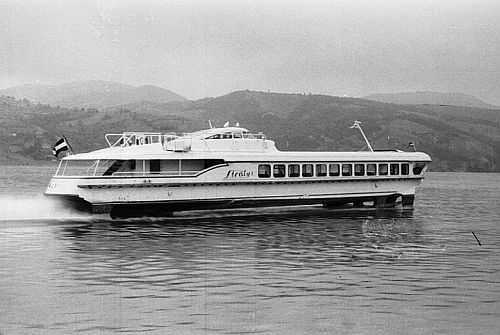
SIRÁLY 1
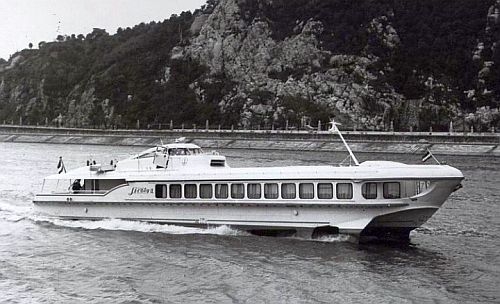
SIRÁLY 2
Plans were made for a Budapest-Belgrade line in 1978, but as no significant flow of tourism was experienced on this route in other modes of transport, either (VOLÁN, MÁV), the plan was never realized.
The increase in passenger traffic went parallel with the growing of the fleet. In spite of that, there was a critical period between 1977 and 1981 when passenger traffic boomed and the rhythm of traffic could only be maintained at its very high level only at the risk of pushing backup boats into service. For example, the trips of AMERICAN EXPRESS Co. were connected to the departures of special hydrofoil lines in Vienna by charter airlines.
Passenger traffic graphs represent and incorporate 30 years of political, ideological, economic, weather, traffic and other factors (e.g. Chernobil), which can have a beneficial or favorable or detrimental effect on passenger traffic. The 1992 graph index is again noteworthy. I would like to highlight two things from that: one is that the eight-boat fleet covers, over and above the combinational opportunities, MAHART’s own lines, the renting of boats and the necessary backup boat as well, and the other is that two POLESJE boats with excellent nautical attributes, BIBIC I and BIBIC II, were put into traffic. These boats were able to complete their journeys without difficulties when the water level was extraordinarily low for nearly 40 days in 1992, resulting in significant cost savings.
The graphs also show that the one millionth passenger will step onboard one of MAHART’s hydrofoils early this year.
What is not visible in the charts is whether it was economical or not to maintain the hydrofoil boats. In the 1960s and 1970s the fares remained unchanged for years, and still remained in the acceptable range after they were raised. Nevertheless, prime costs changed slowly as well, so whatever the “basic plan and facts” index and the financial data behind it showed, the subsidies given under various titles covered everything. So the results in the index numbers only served to make various statistical surveys more varied.
Since the end of the 1980s, the pursuit of profit has taken shape markedly, and the passenger shipping business policy of MAHART has gone in that direction since 1990. It does not have to reckon with potential competitors, and as a consequence its qualified professionals, expanded fleet and the experience of the past 30 years provide a good basis for realizing its novel plans.

